The tarot’s history as a tool of divination goes back to the late eighteenth century, and its use as a deck of playing cards goes back centuries further; it’s no surprise that genre writers have repeatedly incorporated tarot and tarot analogs into their works. Although there’s a lot of fun in characters consulting a fortune teller or a diviner offering crucial insight at a key juncture, some writers have gone deeper. Here are five works of genre fiction that incorporate the tarot or a tarot analog into the worldbuilding of their novels.
Aspects by John M. Ford
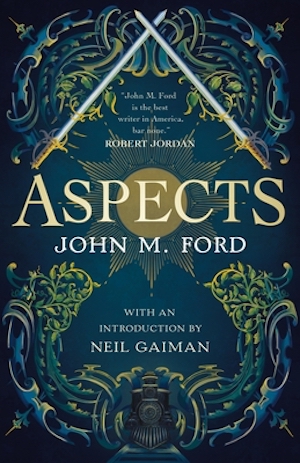
The world of Ford’s final, unfinished novel reveres Goddess instead of God, and She is said to have four aspects and four companions (who are actually part of Her). Only gradually does it become clear that the holy Book of this religion is a 78-card divinatory deck: saying grace, at mealtimes and at partings, involves shuffling a deck and drawing two cards, leaving those assembled to figure out their meaning and how it relates to them.
Probably unintentionally, reading Aspects requires readers to undertake similar interpretation work. As it stands, the novel follows the Coron Varic, a reformist member of the Republic of Lescoray’s upper house of Parliament, as he prepares for a country vacation in the company of his circle of friends. He invites his new love interest, the Coron Longlight, along on impulse, and the novel follows the guests’ sojourn at the house and then accompanies them on their various ways, mostly by train, after it ends. Do Varic and his ally Brook have enemies working against them? Will Longlight extend the railway into her demesne? Will the great national exhibition that is proposed towards the end of the manuscript happen? Ford left only a series of sonnets as signals along the track.
Thus there are two levels in play when the new Archimage Birch, one of the guests at the house, declares in a sermon that “The first thing the Book teaches is that meanings must be found and interpreted.” Like the tarot, the cards of the Book have four suits, and I suspect that may have related to Ford’s planned structure for the series; the four elements and the four seasons are also involved in magic in Lescoray. Even unfinished, Aspects is a masterpiece worth figuring out for yourself.
Nova by Samuel R. Delany
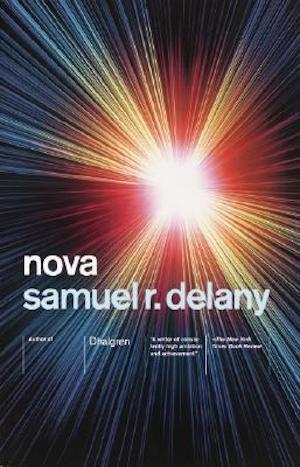
Nominated for the Hugo Award for Best Novel, this is one of Delany’s best and most readable books. Set in the year 3172, the novel follows Lorq Von Ray’s quest to secure a supply of the power source Illyrion. This will allow him to win his feud with his arch-nemesis, and therefore shift the galactic balance of power away from Earth and towards younger political entities like Von Ray’s own Pleiades Federation. Nova is immensely clever on multiple levels, one of them being that it is a classic Grail Quest narrative—and what’s more, characters in the book are aware of it, discussing in the text about how to thwart the supposed fatal curse that falls upon those who finish their Quest tales.
In Delany’s space opera, tarot has become a mainstay of galactic society: the cards are not only widely used for games, as they are in parts of Europe today, but readings are also extremely common and considered scientific. As the would-be novelist Katin tells the Mouse, a skeptic, “…the cards don’t actually predict anything. They simply propagate an educated commentary on present situations—” Astute readers will realize that these remarks describe Lorq’s entire journey, but relating the reading to the plot is part of the enjoyment.
The Elemental Logic series by Laurie J. Marks
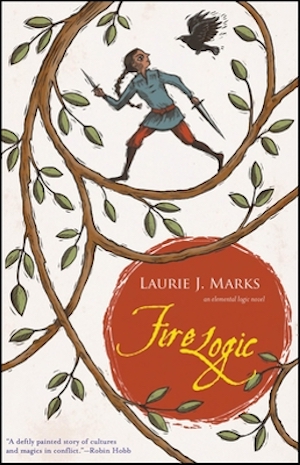
Marks’ four-volume series is set in the country of Shaftal, where individuals whose nature is dominated by one of the four elements are known as elemental witches. As the narrative opens, the ruler of the realm, an earth witch, dies, and the country is overrun by the invading Sainnites. A dozen years later, some Shaftali insurgents and Sainnite soldiers alike are starting to think about giving up the fight. One fire blood in particular, Zanja na’Tarwein, has an incomplete deck of traditional glyph cards, which she uses to help clarify her own intuition and that of her fellow fire bloods.
The glyph cards are important aside from card readings; a plotline in Water Logic revolves around Zanja recovering a formerly lost, complete set of the cards, which reveals that the Shaftali themselves were once invaders, displacing indigenous tribes like Zanja’s and forcing them to the borderlands centuries before. This revelation points to the central tension of the story: how to find a balance between Shaftali, Sainnites, and tribes in a way that acknowledges the harms of the past but enables everyone to move forward together? While you’re reading, you can find out your own elemental balance on Marks’ website.
Murder Must Advertise by Dorothy L. Sayers
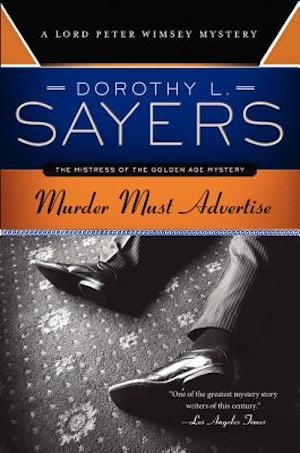
Tarot does not appear directly in the narrative, but some of the major arcana resonate both with the novel’s themes and the themes of the series overall. Sayers’ eighth Lord Peter Wimsey mystery is based on her experiences working in the advertising industry: to catch a murderer, Peter spends almost the whole book undercover, working in an advertising office as Death Bredon. During his investigation, he repeatedly encounters a dissolute group of “bright young things” led by the aristocratic Dian de Momerie, who is usually high out of her mind.
Dian’s ravings about seeing a “hanged man” behind Peter point to the major arcana: she herself can be taken as the Moon, while Peter—in costume as the Harlequin—resonates with the Fool, the protagonist of the major arcana as well as of the novel. On top of that, Peter is closely associated with three cards that follow each other in many decks: Justice, the Hanged Man, and Death. I’ll leave most of these interpretations as an exercise for the reader, but it’s worth nothing that among other things the Hanged Man recalls Wodan, who hung on the tree for nine days and nights, just as Peter takes nine books to become a man in full before he is ready to meet Harriet Vane as an equal in the tenth, Gaudy Night.
The Mask of Mirrors and The Liar’s Knot by M.A. Carrick
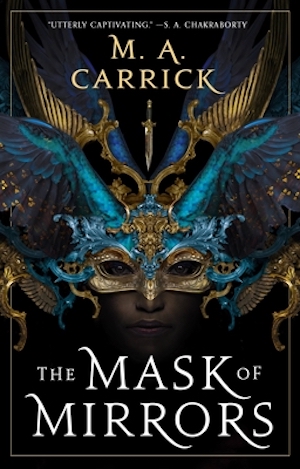
The first two volumes of this trilogy were both published last year, and they’re some of the most swashbuckling fun I’ve had in fantasy recently. Set in the city-state of Nadežra, which was conquered by the Liganti centuries ago, dispossessing its Vraszenian natives, con artist Ren finds herself caught between multiple worlds and roles when she sets out to insinuate herself into the failing noble House Traementis. Along the way, her path tangles with the centuries-old outlaw the Rook, and they learn that Nadežra is still being choked by an ancient danger.
One of Ren’s best weapons is her skill with pattern: she is a true szorsa, a reader of the sixty-card pattern deck that is a key element of Vraszenian culture and religion, and her abilities prove crucial to unraveling the web she and Nadežra are caught in. Furthermore, the titles of each book and each chapter are all those of pattern cards, and the authors even drew actual card readings that they incorporated into the narrative. While you’re waiting for Labyrinth’s Heart, which is scheduled for 2023, you can read more about pattern and draw your own reading.
***
Let me know your picks that got left out in the comments.
Electra Pritchett is a lapsed historian who splits her time between reading, research, and her obsession with birds and parfait. Born in New Jersey, she has lived on three continents and her studies have ranged from ancient Rome to modern Japan.










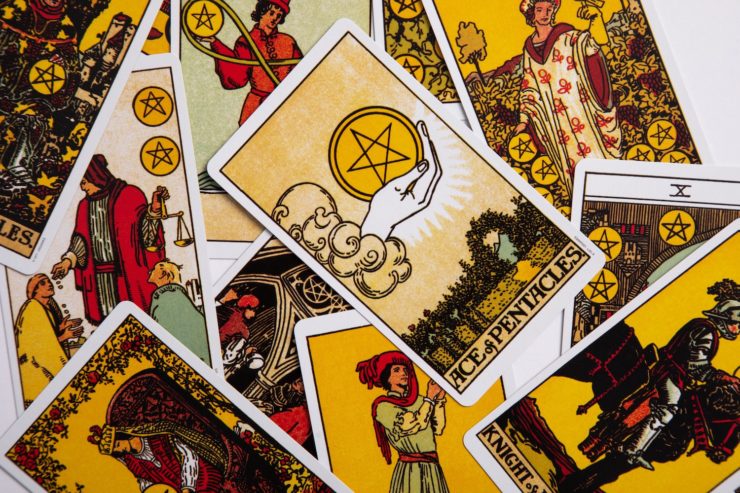
How did you manage to leave out the Chronicles of Amber by Roger Zelazny???
“Last Call” by Tim Powers rightfully should be on this list, any book that anchors on the Tarot, Poker, and the occult origins of Las Vegas is a winner by me!
Charles Williams’ The Greater Trumps is still in print, IIRC, three-quarters of a century after publication. Supernatural thrillers done right… it’s one of seven novels.
Barrington J Bailey Grand Wheel
See also The Greater Trumps by Charles Williams (the member of the Inklings most people forget),first published in 1932. The one, true, “original” tarot deck falls into the possession of a rather ordinary Englishman, whose daughter is engaged to a man who’s of Romany ancestry. Once what he’s acquired becomes known, a conspiracy builds around him to possess the cards, which may not only be able to foretell fortunes, but which may also give the user the ability to influence or change them in the physical world.
There’s also Umberto Eco’s “The Castle of Crossed Destinies.”
Several books by Piers Anthony qualify, including a whole trilogy focused on Tarot (Gods of Tarot, etc.) and the related Cluster books in the same verse.
Second the recommendation above re Amber.
Caroline O’Donoghue’s YA books All Our Hidden Gifts and The Gifts That Bind Us have Irish teen Maeve, who discovers an old tarot deck in her school’s basement and winds up awakening her own latent powers (and those of some friends) and drawing the attention of some dark things by using them. Can’t wait for book 3 in a couple of months! The books are also beautifully illustrated with the cards’ art.
John M. Ford also used tarot in his first novel, Web of Angels. While Aspects is certainly worth reading I would recommend newcomers to Ford start with any of his other novels (some of which have recently been reprinted by Tor, and the others of which will be soon AFAIK).
THE SIX-GUN TAROT, R.S. Belcher. Dark fantasy set in the Old West. Book 1 of series. A group of people, all drawn to the mining town of Golgotha and its magic, must face a dark force that will not only destroy the town but all of Creation. The book chapters have Tarot card names, and some of the characters represent the Tarot face cards. All the characters are well-drawn with flaws and strengths, and the evil characters and their monster are truly terrifying. A real tour de force.
The Greater Trumps! I see it’s already been mentioned above but I’ll say it again. One of my favorite books ever.
In Victoria Goddard’s Greenwing and Dart series, the card game Poacher (with its wonderfully named cards such as the Salmon of Wisdom) has the power to reveal the soul of the players. Although it does not foretell the future, the stories the cards reveal can help shape the characters’ lives. Unfortunately I’m not making it sound as fun as the games are in the books.
If you don’t mind branching out into non-print media, the anime series The Vision of Escaflowne prominently features tarot readings. If you decide to check it out, I recommend going for the Funimation reissue as the first English dub was horrible.
As Rachel Pollack has written a number of books on tarot and has co-edited the Tarot Tales anthology, I would make a guess that they might have incorporated the tarot into at least one of their novels.
The Tarot also figures importantly in Masks of the Illuminati by Robert Anton Wilson. It is a prequel to the Illuminatus! trilogy, set in the early 20th century, and while it does involve some ancestors of characters in the trilogy, it can be read as a standalone (a good thing, since I think the trilogy has aged badly in many ways).
Doris Egan’s The Gate of Ivory and its two sequels
The Least Trumps, Elizabeth Hand’s excellent novella, was originally published in The New Wave Fabulists in 2002, and reprinted in a number of her collections as well as The Year’s Best Fantasy and Horror, Sixteenth Annual Collection in 2003.
The Labyrinth Gate by Alys Rasmussen aka Kate Elliott features a magical deck that moves the heroes to an alternate reality. Contains detailed descriptions of the various cards.
@2. I second Last Call by Tim Powers. Very good, very weird book
And I’ll second the recommendation of Labyrinth Gate – that’s a novel to which I’ve always wanted a sequel, as unlikely a prospect as that may be at this late date.
The Tarot Sequence by K D Edwards
Deck of Dragons
Gravity’s Rainbow by Thomas Pynchon
@6: That would be Italo Calvino’s Castle of Crossed Destinies. But I agree, it’s a great one!
Robertson Davies sprinkles usage and references to the Tarot throughout his works, perhaps most directly in “The Rebel Angels”
It’s not marketed as SFF, and it’s arguable whether it qualifies as genre, but tarot is central in Katy Hays’ The Cloisters, a dark gothic mystery novel of suspense and academic ambition.
@21 I came here to say K D Edwards! The first one is The Last Sun.
I can’t remember if Rachel Pollack actually used the Tarot in her novel Unquenchable Fire, but it’s an amazing fantasy! And her book 78 Degrees of Wisdom is the best book about the Tarot that I know.
IIRC the use of the Dune Tarot to muddle the prescience of Paul Atreides is a plot point in Frank Herbert’s Dune Messiah. I think that M A Foster also has the protagonist’s opponents use Tarot cardsin one of the Morphodite series.
The Raven Ring by Patricia C. Wrede features what is basically Tarot by another name, because it is set in her fantasy world of Lyra. A luck-seer comes to chart the cards, but is using a spell to try to influence the future, and the spell backfires. They try to analyze the cards that were laid before things went wrong, and end up going to an expert wizard to lat a new set to give them some idea of who is going after the main character. This is one of my favorite books, with one of the funniest characters ever!
The Holy by Daniel Quinn is a very weird supernatural thriller with tarot as a big part of the plot. Recommended.
“Lord of The Mysteries” by Cuttlefish who loves diving
the power system is based on tarot cards, you can try to read it if you’re curious
Not quite the Tarot we know on Earth, but I’d like to add, ‘Cards of Grief’ by Jane Yolen.
If I may be so bold as to mention my own novel: The Quiet is Loud features a main character with prophetic dreams, who’s also a professional tarot reader and uses the cards to guide her as her ability disrupts her life.
Honestly so happy to see Elemental Logic on here. It remains one of my all-time favourite series!
Tanith Lee’s A Heroine of the World is supposedly structured after Tarot (according to The Hidden Library of Tanith Lee).
I suppose Piers Anthony’s Tarot trilogy is qualified as well.
The Madigan Chronicles by Marieke Lexmond are fun
@24: Nym checks out.
Emma Bull’s postapocalyptic fantasy(?) Bone Dance uses tarot at various points. It’s also structured around a tarot reading, each chapter being one of the cards.
No one has yet mentioned John Crowley’s Little, Big, one of the best fantasy novels ever, which uses tarot extensively.
And not a book, but Gene Wolfe’s Rhysling-award winning poem “The Computer Iterates the Greater Trumps” deserves a mention too.
Tarot also plays a key role in Susanna Clarke’s Jonathan Strange and Mr. Norrell, which includes the eeriest tarot-reading scene I’ve ever come across in fiction.
Dune Messiah uses tarot as a way to fog prescience
I second The Tarot Sequence by K D Edwards!
On the lesser known side of things, Mark Teppo’s Lightbreaker and Heartland, his Codex of Souls series. Not sure if he’s gonna get the third book out, but I’ve lived for years without it to no ill effect. Check them out if, like me, you don’t fret over unfinished series, cos’ they’re pretty good!
Jonathan Strange & Mr Norrell by Susanna Clarke!
Childermass is constantly consulting his Marseilles deck.
John Ringo’s Princess of Wands might be added.
Christine Feehan just recently released two books that use tarot cards as a central part of the story, Dark Tarot and Dark Whisper. There will be two more in the next two years.
Jenn Stark’s Immortal Vegas series is fantastic, and it continues through her Wilde Justice series! The other characters are major Tarot players, too!!
There are some really fun Tarot scenes (including someone magically changing every card to be the same card) in Jonathan Strange and Mr. Norrell by Susanna Clark
John Sanford’s Kidd novels use Tarot as a devise.
I agree with the first commenter regarding the Zelazny’Amber series. Such a fun read and the cards are so useful.
The Raven Cycle are great and have tarot as a big part of the story as well.
Elemental Masters series by Mercedes Lackey, the book Phoenix and Ashes has an elemental master learning by studying tarot cards.
@52 yes! that was my first thought; I love how tarot cards are used in The Raven Cycle. I guess it’s technically YA but Stiefvater’s work is always nuanced enough to satisfy my grown-up desire for complexity.
This list just bumped the Elemental Logic series up my TBR list a bit, ANOTHER reason I want to read it?! Thank you!
Beautiful Undone by Melissa Polk has a strong thread of tarot running through their retelling of The Fall of the House of Usher.
I would have to say the Malazan books since the entire magic system is based on the houses or holds of the deck.
@41, Stephen Frug, there’s a fair bit of Tarot imagery in Wolfe TBotNS.
Huge kudos to those who pointed out how essential THE GREATER TRUMPS is for this list; one of Charles Williams’s more accessible novels (which isn’t saying much, TBH, but it’s glorious). And don’t forget NIGHTMARE ALLEY by William Gresham!
Per the Little Black Rule: in Traveller, the Droyne species use the coyns (coins, not cards, but the principle is the same) as divinatory tools – and, far more importantly, they are central to the ritual by which an adolescent Droyne is assigned a caste, and without which they will not become completely sapient. (I suspect inspiration from the Pak and tree-of-life root).
Oddly, six of the coyns show the six Major Races who developed jump drive – and they were set in their current form back when five of those races were still banging the rocks together, or even weren’t sapient yet.
Much as I love Wimsey putting him in the list is a stretch.
The first time I even heard of the Tarot was in the Bronze Age “Son of Satan” series from Marvel. Satan moves against his son Damien via a tarot reading, with the card symbols manifesting physically as well as in meaning.
Melissa Scott’s Roads of Heaven series uses images drawn from the tarot in interesting ways. These images are used to navigate space ships (like wormholes). The underlying premise is, what if hermetic magic was developed and used instead of scientific technology?
Amanda Foody’s The Shadow Game series, YA, comes to mind with Ace of Shades, King of Fools and Queen of Volts, excellent but also very dark coming of age story, dancing with high stakes.
And the Immortal Vegas series by Jenn Stark.
I’d like to add Little, Big by John Crowley, which has an unusual tarot deck that may or may not have belonged to the Fairies, and has definitely been altered by them.
Louise Cooper’s early novel The Book of Paradox uses tarot symbolism.
Each chapter is named after one tarot card and apparently the plot reflects the symbolism of the card in question.
I read the book ages ago. I didn’t enjoy it all that much, most likely because the hidden meaning (if there is one) went right over my head.
But maybe tarot lovers will get more out of it than I did.
I’m amazed that no one’s mentioned William Kotzwinkle’s Fata Morgana.